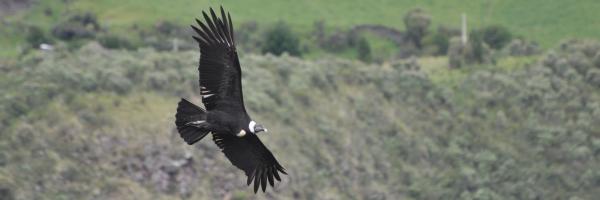Sebastian Kohn
A new collaborative publication reports that the Andean Condor population in Ecuador is more endangered than previously documented. Without prompt intervention and a comprehensive conservation strategy, the Andean Condor faces risk of extinction in Ecuador in the near future.
Andean Condors are highly mobile and among the longest-lived birds in the world, which makes their risk of extinction difficult to study. Their populations were historically widespread and relatively abundant in South America, but there have been extensive population declines in recent decades, particularly in the northern Andes. These regional population declines raised concerns about genetic bottlenecks, connectivity between populations, and the overall state of the Andean Condor population.
This new collaborative study was led by Julián Padró of the National Research Council of Argentina (CONICET) and the University of Göttingen (Germany), with Hernán Vargas of The Peregrine Fund (Ecuador), Jaime Chaves of the Universidad San Francisco de Quito (Ecuador), and several international partners. They examined the genetic and movement patterns of the Andean Condor population in Ecuador to inform a more comprehensive conservation plan. They obtained 40 genetic samples from Andean Condors within Ecuador and additionally tagged 12 condors with GPS tracking devices. The genetic data allowed the researchers to study the level of molecular variability and effective size of the population. The movement information obtained from the GPS trackers allowed them to identify movement corridors and evaluate the connectivity of the population of Ecuador with those of Peru and Colombia.
Their analyses found that the population decline in Ecuador (currently estimated between 94 to 150 individuals) has resulted in a reduction in the number of breeding individuals (estimated to be 53). The connectivity between populations to the north and south appears to be essentially non-existent, even though the landscape should facilitate movement. This suggests that low population densities are limiting connectivity in the northern Andes. The study also found that the small (21 individuals) captive population of condors within Ecuador, which seems to be genetically stable, could be an important resource for reintroducing genetic variation into the wild population.
“Ecuador's Andean Condor population faces a high risk of extinction, not only because of its small population size, small range and geographic isolation from other populations as revealed in this study, but also due to habitat loss, poisoning, and feral dogs. Nevertheless, this study also shows that the small captive population represents a promising local genetic resource to reinforce the wild population through captive breeding efforts,” says Hernán Vargas.
The researchers warn that if the population in Ecuador remains isolated from the other populations, it faces a high risk of extinction in the near future. The researchers recommend a combination of conservation efforts focused on improving connectivity between populations, management of the captive population’s genetic diversity, and further analysis of genetic variation within other populations across South America.
Julián Padró concludes, "This study underscores the importance of integrating genetic and movement data to design effective conservation strategies for this highly mobile vulture. However, more research is needed, especially on the central Andes between the large populations in the south and the decimated ones in the north of the continent. This research will allow us to understand the overall species connectivity and prioritize conservation efforts across the vast Andean territories. Meanwhile, ongoing genomic studies on both wild and captive populations will be essential to inform species management."
The Biological Conservation Journal paper is titled, “Demographic collapse threatens the long-term persistence of Andean condors in the northern Andes”.
To view the publication and learn more about The Peregrine Fund visit www.peregrinefund.org/science-publications.






